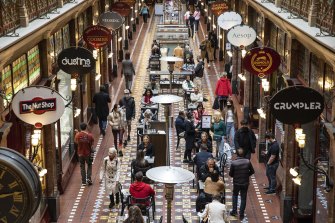Home » World News »
Victorians want to know why the state’s not opening up as quickly as NSW
This week marks an important turning point for Victorians in their experience of the COVID-19 pandemic. Their government has allowed them, for the first time, to take cautious steps out of what has been one of the most restricted communities across the globe. But the question on the lips of many Victorians will be, why aren’t we moving as quickly as New South Wales?
The comparison of the two most populous states has led to sharply polarised commentary often aligning to party political lines. Largely this invective has been thrown from the bully pulpit of daily press conferences on both sides, or from the informal troll farms of social media. It’s a legitimate comparison though, and one that should be analysed on the health evidence as dispassionately as possible.
The Strand Arcade in central Sydney on Monday morning. Victorians are asking why aren’t we moving as fast as NSW?Credit:Jessica Hromas
Both states will be among the most vaccinated places in the world in the matter of weeks. Both states are entering our world-famous summer months, where we will be outdoors and enjoying the best this country has to offer. Both states are similar enough that they could move out of lockdown at the same vaccination-target determined pace.
There are a variety of restrictions that have been relaxed in NSW for the fully vaccinated upon reaching 80 per cent. These include the opening of non-critical retail and personal services such as hairdressers under density limits. Event facilities such as cinemas and art galleries are open again. Weddings, religious services and funerals may occur with no person limits. This is far from the Boris Johnson style “freedom day” where all restrictions are removed in an instant, but it strongly takes into account vaccination as a primary driver of reduced transmission and hospitalisation. So, why is the Victorian approach so much more cautious?
People dance at a “Freedom Day” party at a London club after almost all coronavirus restrictions are lifted.Credit:AP
The framing of children returning to schools is a good case study in the difference in approach. Victoria has mandated masks in children from year 3 upwards in schools. Both the ACT and NSW will strongly recommend masks in that age group but ultimately leave the decision up to the child’s parents or guardian. Chief Health Officer Brett Sutton has stated that this is based on “the evidence” though at best this seems to be based upon evidence from the US, where any interpretation of the efficacy of masks in schools is significantly distorted by vaccination rates. And Australia’s own data from the National Centre for Immunisation Research shows that the risk of either contracting or transmitting the virus among school-aged children remains low.
Even if we accept that there may be some merit in the policy, the interpretation of inconclusive evidence in a conservative way has become a trademark approach, and one reason why the Victorian approach has often been more restrictive throughout the pandemic.
Given this approach, the rules around quarantine after exposures to COVID-19 in school settings is
of particular concern. The current quarantine rules around close contacts in education settings would see schools shut and parents having to stay home from work to look after children who were close contacts. If masks and ventilation systems are designed to allow kids to stay at school despite exposures, then all power to Professor Sutton, but there is no indication that these rules are likely to change for term 4. The whole object of getting schools open is that they stay open, and the quarantine approach must be less cautious to accommodate that. Even more importantly, public health leaders must be reassuring voices about COVID-19 in children, as parents in Victoria and indeed across the nation have been driven to extreme fear of returning their kids to school by over-stated impacts on child health.
When we look toward nations that take a less conservative approach, like Denmark, there are better quarantine options. Classes remain open, the child who has COVID does not attend school until they are better. Close contacts can remain in class with an initial negative test and then get tested again at day 4 and day 6. That is it. All COVID affected states in Australia would be well served looking at the Danish model.
The cautious approach being taken in Victoria is motivated by concerns over the impact on the health system of COVID cases among the unvaccinated who still require hospitalisation and ICU support. However, the hospitalisation curve will inevitably bend down with the effect of vaccination, and hospitalisation rates are already one third lower than the NSW peak despite higher case numbers, a tremendous accomplishment by all Victorians to protect themselves and their community. There seems to be an underlying concern over the powerful effect of vaccination on transmission and hospitalisation evidenced by the modelling assumptions of the Burnet Institute and the comments of Stephen Duckett, both of which claim health care system will be overwhelmed even with the cautious approach Victoria is taking. And yet, the Sydney hospitals are closing their COVID surge wards.
This discussion is not about badgering the Victorian cabinet into moving quicker, they are, after all,
relying on health advice. It is about questioning the caution of the Victorian public health decisions and whether the evidence relied upon to make them is sound. When we examine policies such as curfews, closing playgrounds, extending lockdowns, and now having a very slow ramp out of lockdown at the very time that Australians should be out and about and enjoying the fruits of summer after a long and dark winter, we should respectfully question these decisions.
There is a fundamental starting point in science that in seeking proof that an intervention is effective, it should be first assumed that the intervention does not work, and we seek evidence to disprove this. That seems to have been lost in Victoria’s approach to pandemic policy, and we desperately need it back.
Professor Nick Coatsworth is a former deputy chief medical officer and an infectious disease specialist. Professor Catherine Bennett is chair of epidemiology at Deakin University.
Most Viewed in National
From our partners
Source: Read Full Article




